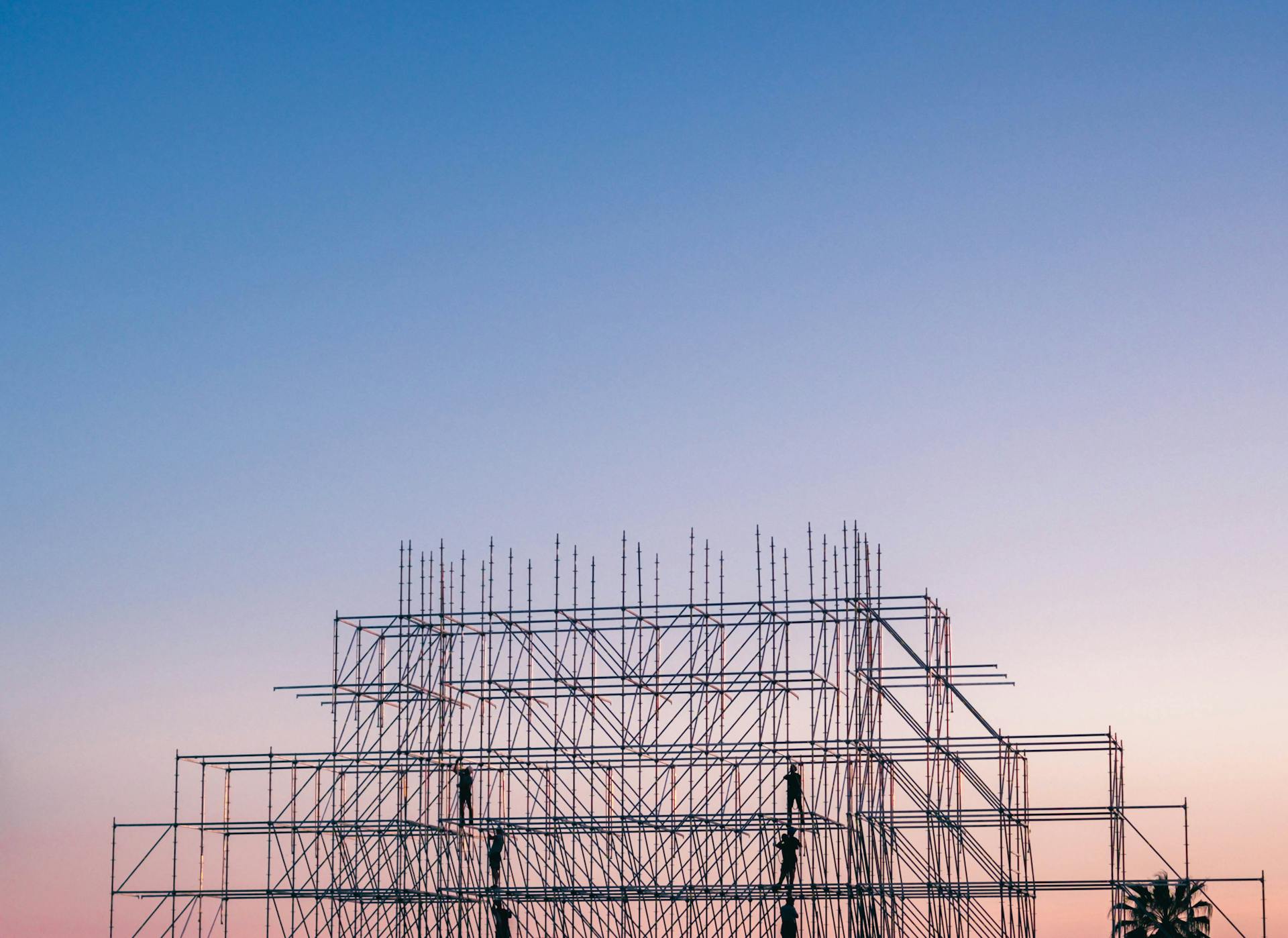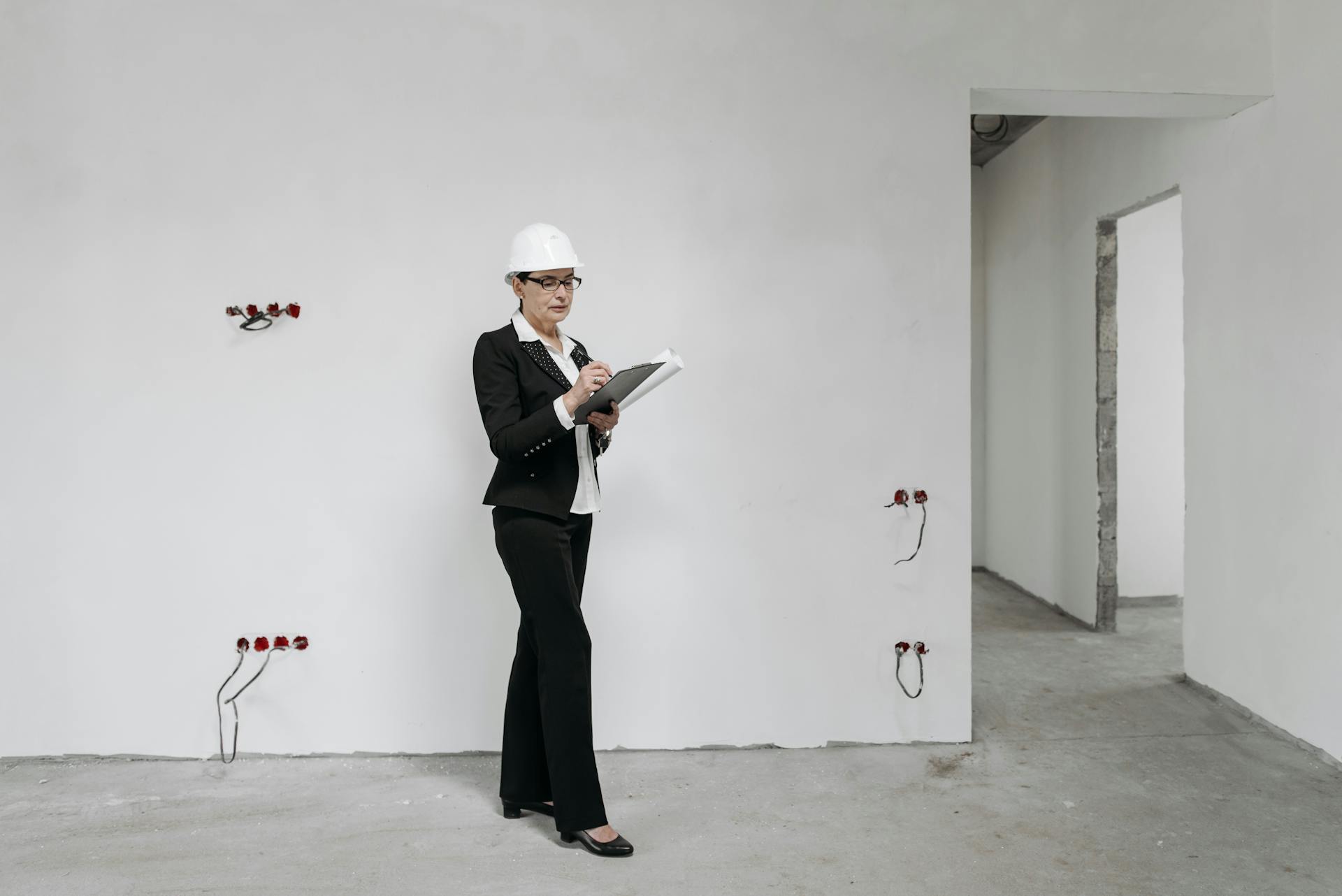
There are several types of construction loans to consider, each with its own benefits and drawbacks.
A construction loan is a short-term loan that covers the cost of building a new home or renovating an existing one. Typically, the loan is interest-only for a set period, usually 6 to 12 months.
Construction loans often require a significant down payment, which can range from 20% to 30% of the total project cost. This can be a major financial hurdle for many homebuyers.
The interest rate on a construction loan can be higher than a traditional mortgage, but it's usually lower than a personal loan.
Explore further: Cost to Lease a Tesla Car per Month
Types of Construction Loans
There are several different types of construction loans available to borrowers. Understanding each type will help you figure out which one you need.
A construction loan is designed to suit various financial needs. You'll need one if you plan to build a brand-new house. Unfortunately, finding a lender and applying for financing isn't as easy as it seems.
Different construction loan types are available to borrowers. Borrowers can choose from these options to find the best fit for their project.
On a similar theme: Different Types of Auto Loans
How Construction Loans Work
Construction loans are a type of loan that covers the cost of the land and construction. Your lender will want to see your plans, projected budget, and schedule before approving the loan.
You don't receive the loan money upfront, but instead, your lender pays your contractor in intervals called draws. These draws help keep the project on schedule.
Most construction loans have a 5-7 draw schedule, but some projects may require more. The first draw might cover getting permits and preparing the land, while the next might cover framing and subflooring.
During the construction phase, lenders usually require interest-only payments, which means you don't start repaying the principal until after construction is finished. This varies depending on your lender and loan.
Some construction loans come with interest reserves, where the lender calculates the interest you'd pay and builds it into the initial loan amount.
Readers also liked: What Insurance Companies Cover Solar Panels
Getting a Construction Loan
Before diving into the process of getting a construction loan, it's essential to get prequalified. This will give you an idea of the amount and terms of a loan that a lender will approve.
Getting prequalified is a no-brainer, as it saves you from wasting time and money on building plans only to find out you don't qualify for financing.
For more insights, see: Refinance Auto Loan Bad Credit Upside down
How to Get
To get a construction loan, you'll need to provide a detailed project plan, including a budget, timeline, and architectural drawings. This will help the lender understand the scope of the project and assess the risk involved.
A construction loan typically requires a 20-25% down payment, which can be a significant upfront cost. You can use your own savings, a gift from a family member, or even a home equity loan to cover this amount.
The lender will also want to see a stable income and good credit history to ensure you can afford the loan payments. A credit score of 650 or higher is usually the minimum requirement.
A construction loan is typically a short-term loan, lasting around 6-12 months, which is just enough time to complete the project. This timeframe gives you the flexibility to make changes or adjustments as needed.
The lender will also require a contingency fund to cover unexpected expenses or delays, which can range from 10-20% of the total project cost.
Get Prequalified
Getting prequalified for a construction loan can save you a lot of time and money. It gives an idea of the amount and terms of a loan that a lender will approve.
Applying for prequalification is a quick and easy process that can be done online or over the phone. This step is crucial before spending a lot of time and money on building plans.
Prequalification is not a guarantee of approval, but it gives you a better understanding of your financial situation and what you can afford. It's like getting a sneak peek at the loan terms before you start making plans.
By getting prequalified, you can avoid getting deep into planning a project only to find out you don't qualify for financing. This can be a costly mistake, both financially and emotionally.
You might like: Car Loans for First Time Buyers with No Credit
Construction Loan Options
Construction loans come in various types to suit different needs. A construction-to-permanent loan, for instance, allows you to convert to a permanent home loan once your house is finished. You only close on the loan once, saving you from paying closing costs twice.
There are also one-time-close loans and two-time-close loans. The former involves a single closing, while the latter requires two separate closings. Typically, lenders hold back 10 percent of the project cost, known as retainage, until the project is complete.
You can choose from various loan types, including construction-to-permanent loans, lot loans, bridge loans, and remodeling loans. Construction-to-permanent loans, for example, can be conventional or government-backed, such as FHA or VA loans.
On a similar theme: Two Kinds of Equity Financing Are
Cover Costs Not Associated with Home Building
A construction loan is a type of loan that covers costs associated with building your new home. Your lender pays your contractor directly, so you won't receive any leftover funds.
You only pay for and pay interest on the money your lender pays your contractor. This is a benefit, as it ensures you're only responsible for the costs of the project.
Here's a breakdown of what a construction loan typically covers:
- Land.
- Plans, permits and fees.
- Labor and materials.
- Contingency reserves (in case the project costs more than estimated).
This means you can focus on finding the perfect plot of land, designing your dream home, and hiring a reliable contractor, without worrying about covering unexpected expenses.
Home Mortgages
A construction-to-permanent loan is a type of loan that converts to a traditional mortgage once the home is built. This loan allows you to complete one round of applications and paperwork and pay one set of closing costs.
During the construction-loan phase, you're only responsible for interest payments on the money drawn, as it's drawn. After the conversion, you start making payments that cover interest and the principal — as you would with any mortgage.
Construction-to-permanent loans offer a one-time closing, so you don't pay duplicate settlement fees. This can save you a significant amount of money.
With a construction-to-permanent loan, you can choose your term of 15 to 30 years, and you can opt for a fixed rate or an adjustable rate. The interest rate is locked in at closing, and some lenders may offer a "float-down option", which would let you get a lower rate at closing if mortgage rates improved during construction.
Suggestion: Car Title Loans Interest Rates
There are two types of construction loans: one-time-close loans and two-time-close loans. One-time-close loans, also known as construction-to-permanent loans, convert to a permanent mortgage at the end of the building phase. Two-time-close loans, also known as construction-only loans, must be refinanced into a more traditional mortgage product after the construction phase is complete.
Here are some key differences between construction loans and traditional mortgages:
- Funds disbursement happens in stages for construction loans.
- The repayment schedule for a home construction loan only requires interest-only payments.
- Inspections happen at the end of each fund disbursement period for a construction loan.
With a construction-only loan, you'll need to qualify, get approved, and go through closing twice — once for the construction loan and once for the permanent mortgage. This can be a more complex and expensive process, but it offers more flexibility in terms of comparing lenders and finding the best deal.
Owner-Builder
If you're planning to build your own home, you'll want to consider an owner-builder loan. This type of loan allows you to act as your own contractor, but it's not for everyone.
Most lenders require applicants to show their expertise, education, and licensing to qualify for an owner-builder loan. You'll need to demonstrate that you have the experience and skill necessary to build the home up to code.
A different take: How to Buy a Car with Your Own Financing
To qualify for an owner-builder loan, you typically need to be a licensed builder by trade. This ensures that you have the necessary expertise to manage the construction process and comply with building codes.
The process of getting an owner-builder loan can be complex, but it's worth it for those who are willing to put in the time and effort. With this type of loan, you'll have the freedom to build your home exactly how you want it.
Here are some key requirements for owner-builder loans:
- License as a builder by trade
- Expertise and education in building
- Experience in managing construction projects
Keep in mind that not all construction lenders offer owner-builder loans, so be sure to shop around and find a lender that meets your needs.
Renovation or Rehabilitation
A renovation or rehabilitation loan can be a great option for homeowners who want to make major changes to their existing home. These loans finance the costs of large improvements, such as adding rooms, a garage, or an in-ground swimming pool.
The lender will typically require an appraiser's estimate of value once the repairs and upgrades are finished, and the amount you can borrow will depend on this estimate. This means you'll need to have a clear plan and budget for the renovation project.
With a renovation loan, the lender will often evaluate the builder and review the budget, and may even oversee the draw schedule to ensure the project stays on track. This level of involvement can be beneficial, especially if you're not experienced in managing large construction projects.
Here are some low-down-payment renovation mortgage programs to consider:
Keep in mind that these programs can also be used to refinance a current mortgage and include the costs of a remodeling project.
Frequently Asked Questions
What is the disadvantage of a construction loan?
Construction loans often come with higher interest rates and additional closing costs, making them more expensive than traditional mortgages. This can lead to increased financial burdens for borrowers.
Do all construction loans require 20% down?
No, not all construction loans require a 20% down payment. Some lenders, like Premier Bank, may offer lower down payment options, such as 10%.
Sources
- https://www.ubuildit.com/common-home-construction-loan-types/
- https://www.bankrate.com/mortgages/construction-loans-explained/
- https://www.reinbrechthomes.com/blog/construction-loans-101-what-you-need-to-know/
- https://www.nerdwallet.com/article/mortgages/construction-loans
- https://www.lendingtree.com/home/mortgage/how-construction-loans-work/
Featured Images: pexels.com

